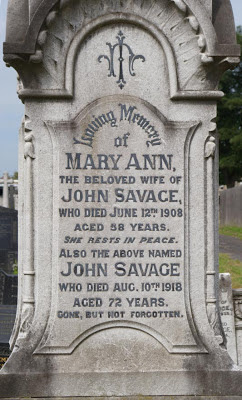 |
| Mary Ann Savage's elaborate memorial |
There aren't many gravestones in the OH's family, let alone ones so elaborate, although to be honest it is stretching a point to say these Savages are the OH's relatives. His great-aunt married a Savage and a distant cousin married the grandson of another in a couple of those convoluted family relationships I'm finding after more than ten years of researching the OH's family in Barnsley.
The Savage family in Barnsley seems to mostly descend from George Savage, born 1767, possibly in Nottinghamshire or Staffordshire, who moved to Barnsley, Yorkshire between 1815 and 1819, having already had a large family in Newark, Nottinghamshire. The story of one branch of his family is told in 'Moving Lives' a book published by the Barnsley Family History Society some years ago which is still available from GenFair.
I only took a picture of this memorial on our way out of the cemetery last week because it caught my eye as we were leaving. At that point I wasn't even sure that Mary Ann and John Savage were related to the rest of the family who are so tentatively linked to ours. Checking the family tree the following day as I transcribed the stone for the Billion Graves website I soon tracked them down ...
The John Savage on the memorial is the grandson of the original George Savage by his youngest son, Joseph, the only one of George's children born in Barnsley. His father was a weaver when John married Mary Ann Brown in 1869 at St John's church which lay in the middle of one of the poorest districts of Barnsley. I wrote a blog post last year about Wilson's Piece as the area was called then. So how did a man from a poor part of town, the son of a youngest son, so no family money to depend on in all likelihood, how did that man manage to succeed to the extent that he could afford such an elaborate memorial to his wife?
 |
| Sheffield Independent Saturday 27 March 1869 (from Find My Past - Newspapers) |
 |
| The 1889 map of the junction of New Street and Sheffield Road Showing the Black Moors Head, the Clarence Hotel and the Melbourne Hotel |
 |
| Close up of the Inscription on Mary Ann and John's Gravestone |
And the explanation for the title of this blog post ... Well, Mary Ann Savage dies in 1908 after 39 years of marriage - she has borne at least nine children - those are the ones I've found in various census returns and the author of the family story in Moving Lives mentions John and Mary having TWELVE children! So she had a long and busy life.
Her sister Elizabeth Patterson (remember, she married the solicitor's clerk in 1879) had been a widow for thirteen years at this point, her husband had died in 1896 and her only son was living away from home, managing a hotel (another member of the family in the pub trade) in Hoyland.
We can only imagine that John and Elizabeth found comfort in each other after her sister's death. A law had been passed in 1907 allowing a man to marry his deceased wife's sister - it had previously been prohibited for many years by the church and this prohibition had been carried forward into civil law. There was no reason for them not to marry if they wanted to, so in 1909 they did - about a year after Mary Ann's death. I can't find the marriage in the parish records on Ancestry, so I assume it was a quiet affair in the Register Office.
Elizabeth died in 1913 and was buried with her first husband. John passed away in 1918, at the grand age of 72 years leaving £13,000 in his will which is about half a million pounds in today's money - his house on Huddersfield Road is probably worth that by now! Given the number of children and grandchildren he had by then it was probably spread pretty thinly even so.

No comments:
Post a Comment